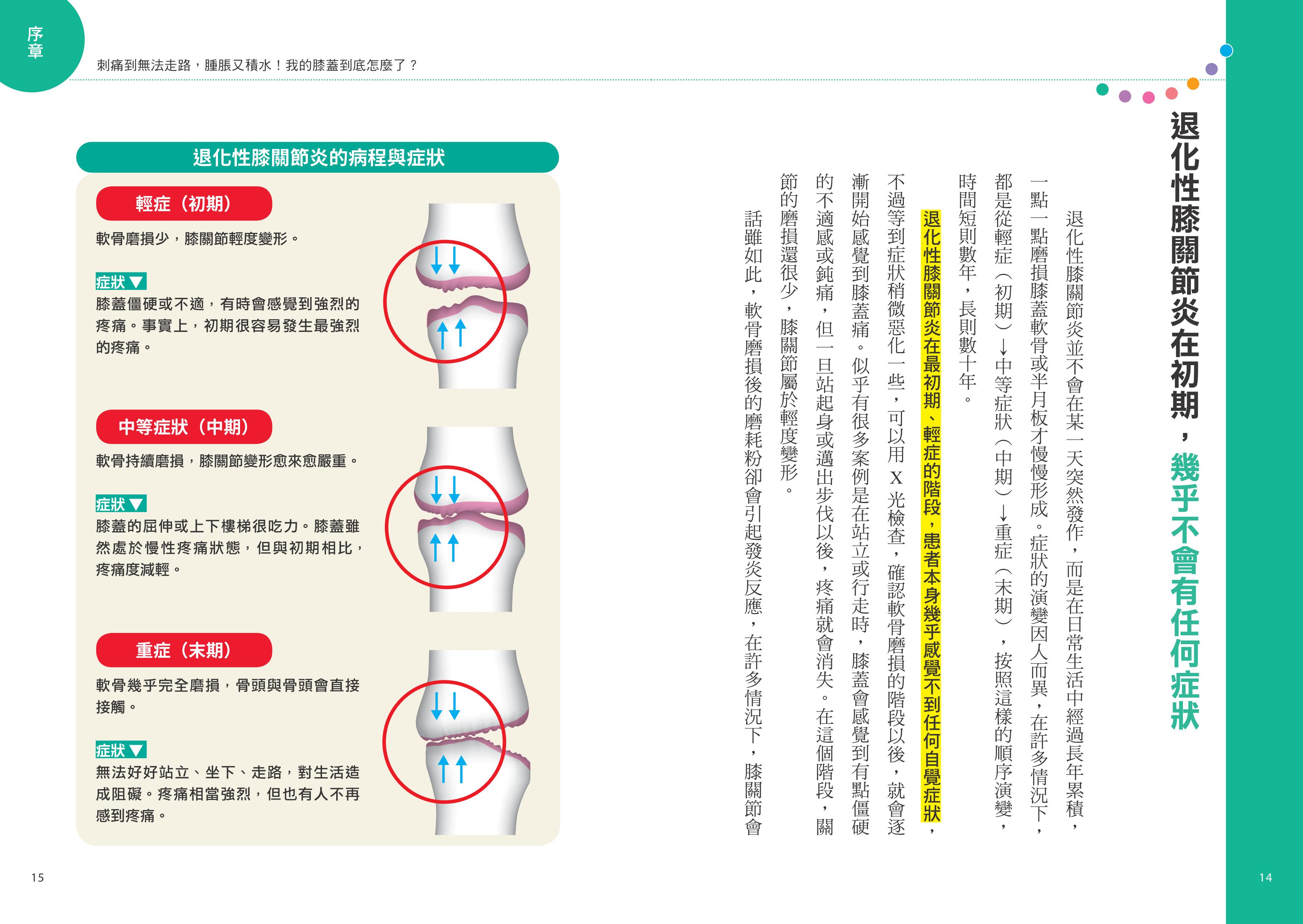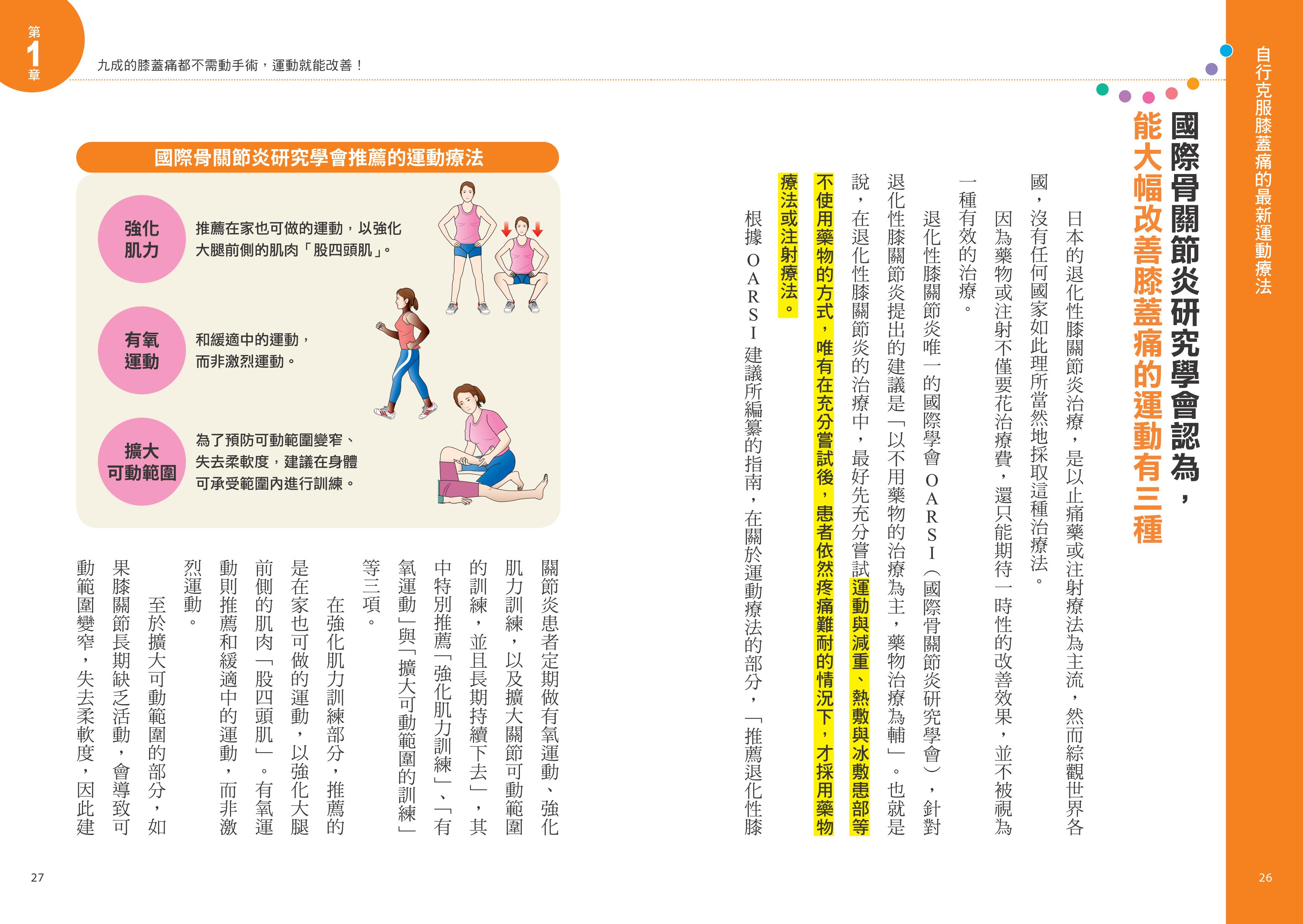
| 中文書名 | 膝蓋解痛全圖解:日本膝關節名醫教你10種護膝運動,在家就可消除膝蓋痛!(最快1分鐘即可改善) |
| 原文書名 | ひざ痛変形性膝関節症自力でよくなる! ひざの名医が教える最新1分体操大全 |
| 作 者 | 黑澤尚、池內昌彥、渡邊淳也、巽一郎 |
| 譯 者 | 劉格安 |
| 系 列 | 健康力 |
| 出 版 | 聯經出版 |
| 出版日期 | 2022/06/09 |
| EAN | 9789570863192 |
| 書本尺寸 | 長21×寬14.8×高1.1cm / 144頁 |
| 印 刷 | 平裝 / 25開 / 全彩印刷 |
內容簡介
大部分的膝蓋痛都不用動手術,
「在家運動」就能改善!
退化性膝關節炎、膝蓋積水、O型腿、軟骨損傷都適用!
──膝關節名醫獨創「1分鐘護膝操」,即刻修復膝蓋──
如果你有這些症狀,請立刻翻閱本書!
▍退化性膝關節炎
▍一走路膝蓋就會痛,睡覺時也痛
▍站起來時,膝蓋會痛、水腫
▍無法順暢蹲下、起立
▍只能正坐,無法跪坐
▍膝蓋無力,爬樓梯很辛苦
▍O型腿導致膝蓋痛
▍膝蓋受過傷,需長期復健
★ 膝蓋為什麼會痛?
日本膝關節名醫黑澤尚認為,大多是因為「退化性膝關節炎」所致,這是一種膝蓋因長年負荷,導致軟骨磨損發炎,進而使關節變形的疾病。除此之外,半月板損傷、痛風、韌帶斷裂或類風濕性關節炎等,也會造成膝蓋疼痛。
★ 如何強化膝蓋,不再疼痛?「1分鐘護膝操」適合所有人
支撐膝關節的骨骼、軟骨、肌肉或韌帶,必須透過運動給予適度刺激,否則會慢慢退化。由日本膝關節名醫獨創的「1分鐘護膝操」,能針對症狀進行修復,緩和疼痛,是最適合患者的自癒療法。
【鍛鍊①】抬腳體操──強化大腿肌力,最快7天可解痛!
【鍛鍊②】扶桌正踏──可提高膝蓋功能並消除疼痛。
【鍛鍊③】緩慢屈伸──適合在入浴時進行,擴大膝蓋的可動範圍。
【鍛鍊④】膝蓋輕屈伸──先彎曲再伸直膝蓋,可增加軟骨內的蛋白聚醣。
【鍛鍊⑤】縮起腳趾──鍛鍊股四頭肌,疼痛大幅改善。
★【真人實證】每天做「1分鐘護膝操」,膝蓋不再疼痛了!
‧曾被診斷無法走路,因持續做操治好疼痛,也能上健身房了!──60多歲,小川太太
‧原本無法跪坐,開始做扶桌正踏及走路五千步後,膝蓋不再腫脹!──74歲,白川奶奶
‧每天做縮起腳趾,膝蓋痛不僅完全消除,甚至能登山健行!──78歲,小島先生
本書特色
▍收錄各式膝蓋痛案例,提供解痛方式。
▍內容穿插大量彩圖,字大且容易閱讀。
▍真人示範動作內容,學習更上手。
目次
- 【前言】每天做一分鐘護膝操,緩解膝蓋疼痛
-
序章 刺痛到無法走路,腫脹又積水!我的膝蓋到底怎麼了?
- 膝蓋痛的原因,高達九成是「退化性膝關節炎」
- 退化性膝關節炎在初期,幾乎不會有任何症狀
- 導致膝蓋痛的原因很多,常見疾病有六種
-
-
第一章 九成的膝蓋痛都不需動手術,運動就能改善!
- 「膝蓋痛只要休息就會好」是錯誤觀念,會導致軟骨磨損得更快
- 高達九成的膝蓋痛都不需動手術,「運動療法」效果更勝藥物
- 國際骨關節炎研究學會認為,能大幅改善膝蓋痛的運動有三種
- 在不會痛的前提下活動膝蓋,即使發熱或腫脹時也可進行
-
-
第二章 強化肌力的重點是鍛鍊大腿「股四頭肌」,「抬腳操」是最簡單的運動
- 鍛鍊大腿的股四頭肌,能強化膝蓋、預防軟骨磨損
- 做「抬腳操」可強化大腿肌力,即膝蓋伸直,慢慢抬腳十公分
- 開始做抬腳操後,多數人的疼痛會在一到兩週內消失
- 止痛藥及關節注射皆無效,靠抬腳操及減重治好膝蓋痛
- 曾被診斷無法走路的患者,因持續做抬腳操治好疼痛
- 泡澡時可試著活動大腿,能打造強壯的股四頭肌
- 開始做強化大腿肌肉運動後,從不能走路到爬梯參拜神社!
-
-
第三章 有氧運動以步行為最佳,但疼痛很強烈時,請從扶桌正踏開始
- 提高膝蓋功能並消除疼痛,以有氧運動最重要
- 膝蓋痛患者不宜過度走路,「扶桌正踏」適合在家練習
- 先練習扶桌正踏,待膝蓋不痛時再開始步行
- 無法跪坐的末期膝蓋痛患者,靠扶桌正踏及走路五千步改善症狀
-
-
第四章 入浴時進行一分鐘緩慢屈伸,可擴大膝蓋的可動範圍
- 膝蓋愈痛愈需要伸展,可避免僵硬並擴大可動範圍
- 熱敷及緩慢屈伸運動,有效消除膝蓋僵硬
-
-
第五章 難以治癒的膝蓋痛找到原因了!滑動膝蓋骨可放鬆髕骨下脂肪墊
- 最新研究發現,膝蓋痛也可能是「髕骨下脂肪墊」所致
- 髕骨下脂肪墊若長期發炎,會使膝蓋的痛感增加
- 按壓髕骨肌鍵,可判斷疼痛是否來自髕骨下脂肪墊
- 只要上下滑動膝蓋骨,疼痛就會立即緩和
-
-
第六章 膝蓋痛是因為軟骨中「蛋白聚醣」減少,多做膝蓋輕屈伸可改善
- 增加軟骨中的「蛋白聚醣」,防止膝蓋痛惡化
- 輕輕彎曲再伸直膝蓋,高齡者也能增加軟骨中的蛋白聚醣
- 做膝蓋輕屈伸與計時跨步走後,膝蓋內的蛋白聚醣增加了
- 每天做膝蓋輕屈伸與計時跨步走,減輕膝蓋痛及腫脹
- 退化性膝關節炎患者只做操三個月,蛋白聚醣便不再減少
- 曾以為要換人工關節,練習膝蓋輕屈伸後,能長時間步行了
-
-
第七章 每天做「縮起腳趾三秒」,曾被建議動手術的嚴重膝蓋痛消失了!
- 練習「縮起腳趾」,近半數患者不用手術!
- 膝蓋軟骨嚴重磨損、大腿骨彎曲,不動手術也能好轉
-
-
第八章 O型腿代表軟骨磨損,「翹小趾走路」可預防惡化
- O型腿透過「翹小趾走路」矯正後,疼痛消失、腿也變直了!
- 深受O型腿所苦,用「翹小趾走路」取代手術
-
-
第九章 從新藥、手術到再生醫療,退化性膝關節炎不再是難症
- 【藥物治療】包括止痛藥、玻尿酸注射等,可依需求使用
- 【物理及裝具治療】使用矯正O型腿的鞋墊或護膝,能減輕膝蓋負擔
- 【內視鏡手術】負擔最輕、術後恢復最快,但效果有限
- 【人工膝關節置換手術】消除膝蓋痛最有效,但術後仍不可跪坐或激烈運動
- 【再生醫療】部分對膝蓋軟骨損傷或變形半月板有效,屬自費項目
-
- 本書作者介紹
好評推薦
王偉全|台灣增生療法醫學會理事長暨超全能診所院長
林瀛洲|台灣運動醫學學會理事長
侯鐘堡|原力復健科院長
蔡忠憲|康富物理治療所院長
──健康推薦(依姓氏筆劃排列)
好評推薦 鼓舞人心!讓你不再害怕膝痛,找回自癒超能力!
──王偉全,台灣增生療法醫學會理事長暨超全能診所院長
退化性關節炎,必定要嘗試的運動治療!!!
──侯鐘堡,原力復健科院長
作者簡介
作者:
黑澤尚 順天堂大學醫學系骨科學特聘教授、社會醫療法人社團順江會江東醫院理事長。
東京大學醫學系畢業後,曾任東京大學骨科助手、都立台東醫院骨科主任醫師。曾至美國哈佛大學布萊根婦女醫院進修,返國後先後擔任東京大學醫學系骨科講師、東京遞信醫院骨科部長、順天堂大學骨科主任教授、順天堂東京江東高齡者醫療中心副院長、順天堂大學醫學系骨科學特聘教授,現為社會醫療法人社團順江會江東醫院理事長。
1980年代初期,是首位在內視鏡下,完成膝部前十字韌帶損傷重建手術的世界紀錄保持者。1980年代後期,則提出「在家做運動可改善膝蓋痛並預防復發」言論,進而提倡「黑澤式膝蓋復健操」,此研究已經過世界實證,目前已成為治療膝蓋痛的標準方式。
黑澤尚醫師同時也是日本骨科學會骨科專門醫師暨評審員、日本骨科學會運動認證醫師、日本體育協會認證運動醫師、日本關節鏡、膝蓋及運動骨科學會名譽會員。專攻腰部、膝蓋等疾病及運動療法,包括關節痛、運動外傷、關節鏡手術。
作者:
池內昌彥 高知大學醫學系骨科教授。
高知大學醫學系畢業後,曾任高知大學教育研究部醫療學系准教授,2014年升任高知大學醫學系骨科教授。目前為日本關節鏡、膝蓋及運動骨科學會理事、日本關節病學會理事、日本運動系統疼痛學會理事。專攻關節病學、膝關節外科、運動醫學,尤其專精退化性膝關節炎及關節痛。
作者:
渡邊淳也 千葉大學醫學研究院特聘教授。
千葉大學醫學系畢業後,曾任千葉大學附屬醫院骨科醫師、東千葉醫療中心復健科部長等職位,2016年起擔任千葉大學醫學研究院特聘教授。目前為日本骨科學會專門醫師、日本骨科學會運動認證醫師、日本骨科學會風濕病認證醫師,及日本復健學會臨床認證醫師。
作者:
巽一郎 一宮西醫院人工關節中心長。
大阪市立大學畢業後,曾擔任大阪市立大學醫學系骨科教授、大阪府立身體障礙者福祉醫院醫師、湘南鎌倉綜合醫院人工膝關節中心長等,2020年起擔任一宮西醫院人工關節中心長。曾在美國梅奧診所及英國牛津大學進修,學習最先進且對身體負擔較小的手術方式,目前為日本首屈一指且專精於「半置換手術」的醫師。
譯者:
劉格安 政治大學畢業,現為專職譯者,譯作類型包含商管、醫學、旅遊、生活、歷史和小說等。
作者序
作者序/每天做一分鐘護膝操,緩解膝蓋疼痛/順天堂大學醫學系骨科學特聘教授 黑澤尚
不曉得翻閱本書的讀者,是否都因為膝蓋痛(退化性膝關節炎)遲遲無法改善,飽受疼痛、腫脹、步行困難等痛苦症狀所折磨?
這類膝蓋痛患者每每前往醫院,最常聽到的一句話就是:「請盡量多休息靜養。」在初期疼痛劇烈時,的確可以建議暫時休息靜養,但假如長期都在休息,支撐膝關節的骨骼、…
內文連載


■ 「膝蓋痛只要休息就會好」是錯誤觀念,會導致軟骨磨損得更快
我從距今四十多年前開始,就在倡導運動療法的有效性,並大幅推翻了治療膝蓋痛的常識。
在那之前,膝蓋痛的患者都被建議要「靜養」,用止痛藥緩和疼痛並休息,以避免造成膝蓋負擔,仰賴自然恢復的能力,等待痊癒。
不過如果整天休息靜養,膝蓋周圍的肌肉或韌帶(連接骨頭與骨頭的強韌纖維組織)就會逐漸衰退(即所謂的廢用症候群),而支撐膝蓋的肌肉或韌帶一旦衰退,就會對軟骨造成額外的負荷,使磨損愈來愈嚴重。
此外,在靜養之餘使用止痛藥,儘管能夠治好膝蓋痛,但若故態復萌地使用膝蓋,由於支撐膝蓋的肌肉或韌帶衰退,過一陣子以後,膝蓋痛就會再度發作。若採用以往的治療法,很容易陷入這種發炎的惡性循環中。
相對於此,若採用我所推薦的運動療法,大約二至三週疼痛就會減輕,開始可以輕鬆地走路。
如此一來,隨著日常生活的活動力增加,膝蓋周圍的肌肉或韌帶自然會得到鍛鍊,有助於抑制關節軟骨的磨損。最後膝關節將不再那麼容易發炎,疼痛也會日益減輕。
疼痛減輕以後,患者的行動會更活躍,進一步強化膝關節的穩定度,擺脫膝蓋痛的糾纏。唯有透過這種良性循環,才能夠真正告別膝蓋痛。
■ 高達九成的膝蓋痛都不需動手術,「運動療法」效果更勝藥物
當膝蓋出現疼痛或不適等症狀時,一般會先前往骨科接受診療。做完檢查後,一旦被診斷為退化性膝關節炎,多數情況下應該會採取藥物療法、運動療法、裝具療法、溫熱療法、注射療法,或復健等非侵入性治療。
在症狀較輕微的情況下,很多案例會先使用藥布或藥膏,暫時觀察病情,但一旦症狀惡化,也有可能改採內服止痛藥或在關節內注射玻尿酸等治療。假如膝蓋連屈伸都很困難,已經嚴重到出現步行障礙時,也可能要考慮動手術。然而,因為退化性膝關節炎而必須動手術的患者,其實非常少數。
請參閱左圖,這是膝蓋痛嚴重程度與患者人數分布的金字塔圖。圖的面積代表退化性膝關節炎的患者人數,愈往上代表程度愈嚴重。退化性膝關節炎的患者人數推估約為兩千四百萬人,其中需要動手術的只有頂端部分約七萬人而已。換句話說,九九%以上的患者都是經由非侵入性治療改善的。
在非侵入性治療當中,運動療法尤其重要。運動療法不僅可以抑制發炎、改善膝蓋痛的問題,還有助於強化衰退的肌肉或韌帶(連接骨頭與骨頭的強韌纖維組織),預防復發。因此,運動療法對於退化性膝關節炎的效果,可以說是勝過藥物治療。下一篇文章將會詳細說明,運動療法為何是最先進的「膝蓋痛標準治療法」。
...









